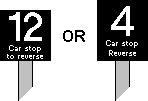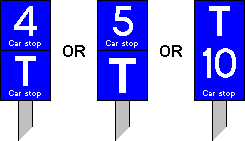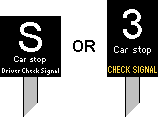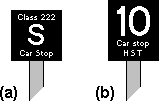Section 21: Stopping Markers
(Page 5 of 9)
|
A board worded "ATP car stop" [21.89] was provided at Aynho Junction in March 2003. Its purpose is to indicate to drivers of ATP-fitted trains reversing at Aynho Junction and returning to Bicester North, the precise location where to stand. The train must be stopped at a precise location to enable the ATP Train Control system to set up correctly. This board was removed in March 2011.
|
 |
[21.89] "ATP Car Stop" Board.
Area: Aynho Junction
Usage: Low
Status: Historical
|
|
|
In 2003, further 'remote platform starting signal' identification signs were provided throughout the Scotland Region. The small diagonal square above the telephone number (see [21.86]) was omitted on these later examples [21.90].
|
 |
[21.90] 'Remote Platform Starting Signal' Identification Sign.
Area: Scotland Region
Usage: Medium
Status: Current
|
|
A separate car stop marker may be provided to indicate the stopping position for trains that will turn back at a station [21.91 - 21.94]. These indicate a different stopping point from the normal position, for trains that are to reverse.
 |
 |
 |
 |
[21.91] Car Stop Marker for reversing trains.
Area: Various
Usage: Low
Status: Current
|
[21.92] Car Stop Marker for reversing trains.
Area: Various
Usage: Medium
Status: Current
|
[21.93] Car Stop Marker for reversing trains.
Area: Various
Usage: Low
Status: Current
|
[21.94] Car Stop Marker for reversing trains.
Area: Various
Usage: Low
Status: Current
|
|
Special stop markers for reversing trains, with a purple background [21.95], were installed at Ipswich station in December 2003 and subsequently also at Witham and Reading.
|
 |
[21.95] Car Stop Marker for reversing trains.
Area: Various
Usage: Medium
Status: Current
|
|
At stations managed by Southeastern, a car stop marker supplemented by an additional "T" sign [21.96] indicates the stopping position for services that will turn back. Newer equivalent markers have the letter "T" included as a suffix and omit the words "car stop" [21.97], and the applicable class of unit may be shown underneath [21.98].
 |
 |
 |
[21.96] Car Stop Marker for services turning back.
Area: Southeastern
Usage: Low
Status: Obsolescent
|
[21.97] Stop Marker for services turning back (e.g. applicable to all train lengths).
Area: Southeastern
Usage: Medium
Status: Current
|
[21.98] Stop Marker for services turning back (e.g. applicable to 10-car Class 465 trains).
Area: Southeastern
Usage: Low
Status: Current
|
|
A special stop marker was installed beside the Up Stour line at Monument Lane in Birmingham in March 2004, on the approach to signal NS301. Bearing the characters "VT 390 X" on a white background surrounded by a red border [21.99], the sign indicated where Class 390 'Pendolino' trains should stop when the signal was at 'danger', to ensure that their pantographs did not come to rest too close to the nearby booster transformer. The signal was replaced by one in a different position when the Birmingham New Street area was resignalled in December 2022.
|
 |
[21.99] Class 390 Stop Marker.
Area: Monument Lane, Birmingham
Usage: Low
Status: Historical
|
|
'Selective Door Operation' (SDO) is a system for limiting the amount of power-operated passenger doors that can be opened on a train when stopped at a station with a short platform. In connection with this, square white boards bearing a figure below the initials "SDO" [21.100] were provided in 2004 at stations where Midland Mainline Class 222 'Meridian' units call. The figure on the board informs drivers of Class 222 units as to the number of cars that may have their doors opened at the platform concerned, so that the Selective Door Operation can be carried out accordingly. SDO boards at stations managed by Southern have a blue background [21.101]. Class 465 'Networker' units also have a facility for Selective Door Operation. Depending on the circumstances at a particular platform, a sign may be installed which takes the form of a train class specific notice board (see [26.20]) bearing the initials "SDO" with a letter "F", "R" or "B" for "front", "rear" or "both", as appropriate [21.102].
 |
 |
 |
[21.100] Selective Door Operation Board.
Area: Midland Mainline
Usage: High
Status: Current
|
[21.101] Selective Door Operation Board.

Area: Southern (subsequently Govia Thameslink Railway)
Usage: High
Status: Current
|
[21.102] Selective Door Operation Board applicable to Class 465 trains (e.g. "F" for Front).
Area: Various
Usage: Low
Status: Uncertain
|
|
Markers in connection with SDO are provided at certain stations between Salisbury and Exeter. Placed facing the track, they bear the words "selective door opening marker" together with a triangle pointing to the left or right as appropriate, inside which is stated the applicable direction, "Up" or "Down" [21.103].
|
 |
[21.103] Selective Door Opening Marker (e.g. Down direction).
Area: Salisbury - Exeter
Usage: Low
Status: Current
|
|
|
During part of 2004 and 2005, passenger services between Edinburgh Waverley and North Berwick were formed of Mark 3 coaches with a Class 90 electric locomotive at one end and a driving van trailer (DVT) at the other end. Stop markers applicable to these trains were provided at three locations in May 2004. Those at Edinburgh Waverley station (Platform 10), Musselburgh station (Down platform) and the entrance to Slateford sidings bore the legends "ScotRail 90/DVT stop", "ScotRail Class 90 stop" and "ScotRail DVT stop", respectively. Each marker had a purple band at the bottom with ScotRail branding on it [21.104].
|
 |
[21.104] Class 90/DVT Stop Marker.
Area: ScotRail
Usage: Low
Status: Historical
|
|
|
In December 2004, car stop markers with a letter "X" [21.105] were installed at each end of the short platform at Bearley station. These apply only to Chiltern Railways services formed of 3-car Class 165 and 168 units.
|
 |
[21.105] "X Car Stop" Marker.

Area: Bearley
Usage: Low
Status: Current
|
|
|
At stations where trains are required to stop adjacent to platform monitors provided in connection with Driver Only Operation (DOO), the associated stop markers may bear the words "car monitors" [21.106] instead of the usual words "car stop".
|
 |
[21.106] "Car Monitors" Marker.
Area: Various
Usage: Medium
Status: Current
|
|
|
The 'remote platform starting signal' identification signs provided at the new Gartcosh station in 2005 differed from previous designs in that they incorporated a downward pointing arrow [21.107]. Similar signs were installed at the reopened Laurencekirk station in 2009.
|
 |
[21.107] 'Remote Platform Starting Signal' Identification Sign.
Area: Scotland Route
Usage: Medium
Status: Obsolescent
|
|
|
The standard form of car stop marker may have additional text reminding drivers to check the aspect shown by the platform starting signal, where provided [21.108].
|
 |
[21.108] Car Stop Marker with reminder to check signal.
Area: Various
Usage: Low
Status: Uncertain
|
|






